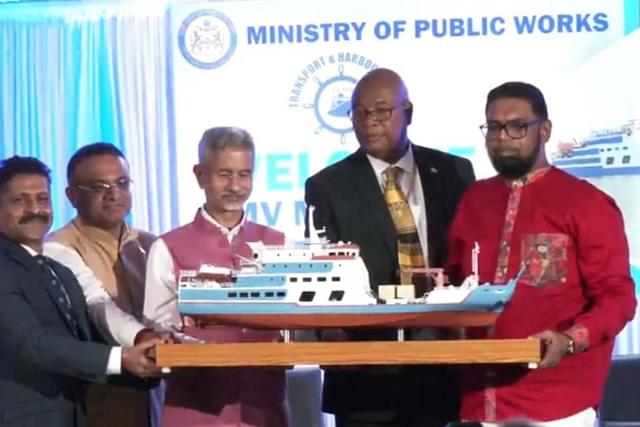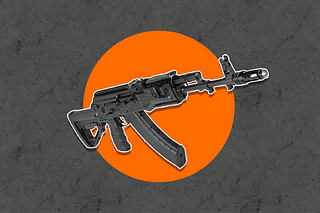Commentary
Kolkata Shipbuilder Delivers Ocean-Going Vessel To Guyana; Why It Is Significant
Jaideep Mazumdar
Apr 26, 2023, 11:20 AM | Updated 01:07 PM IST
Save & read from anywhere!
Bookmark stories for easy access on any device or the Swarajya app.

Nearly 185 years after a British ship, SS (steamship) Whitby, carrying 396 Indian indentured labourers set sail from Kolkata to reach Guyana, an ocean-going ship made in Kolkata sailed 11,500 nautical miles to reach the shores of the South American coastal nation last week.
MV (Merchant Vessel) Ma Lisha, constructed by Kolkata’s public-sector Garden Reach Shipbuilders & Engineers (GRSE), set sail from the city’s port on 12 January and reached Georgetown (capital of Guyana) last week.
The route taken by the new vessel that can carry 294 passengers, 16 motor vehicles and other cargo, was exactly the same taken by SS Whitby. Incidentally, the British ship docked at Georgetown on 5 May 1838.
The construction and delivery of the ocean-going vessel to faraway Guyana is a new milestone in India’s shipbuilding industry. No shipbuilder in the country has done this earlier, said GRSE chairman-cum-managing director, retired Indian Navy Commodore PR Hari.
The importance of the delivery of this ship to Guyana can be gauged from the fact that India’s External Affairs minister, S Jaishankar, flew down to Georgetown to be present at the launch of the vessel there, on Tuesday (25 April).
Guyana’s president Mohammed Irfan Ali, Prime Minister Mark Anthony Phillips, public works minister Bishop Juan Edgill and Indian envoy to Guyana KJ Srinivas were present at the ceremony.
The 70-metre-long MV Ma Lisha that can attain a top speed of 15 knots (27.78 kmph) will be the fastest and largest ferry in Guyana.
Guyana’s president Irfan Ali said the delivery of the Indian-built ship holds special significance for the people of Guyana.
The significance
This event exemplifies the transformation of India from a country colonised by the British who forcibly took away lakhs of poor Indians and made them work in faraway lands under brutal conditions for a pittance to a nation that is now capable of making modern ocean-going vessels for those faraway countries.
Guyana’s regional development minister Anand Persaud, in an e-mail interaction with Swarajya, said it was also very symbolic that the Indian-made vessel reached the shores of Guyana around the same time that the first British ship carrying Indian indentured labourers landed there 185 years ago.
Persaud said that a bronze sculpture of SS Whitby presented to Guyana by the Indian Government was installed at the Guyana National Park in Georgetown on 5 May 1988.
An Indian Immigration Monument to commemorate the landing of the first Indian indentured labourers in Guyana was unveiled by the then president David A Granger on 5 May 2019.
How Indians landed in Guyana
When the British outlawed the enslavement of labourers brought from Africa, the newly-emancipated Africans who were slaves in sugarcane plantations in Guyana refused to work in those plantations for lowly wages.
The plantation owners—all British—appealed to their government for help. The British colonialists turned to India with its vast population of farmers and farm labourers, and replaced African slaves with Indian indentured labourers.
Under the new indentured labour system, the Indian labourers were required to give their consent to be transported to faraway colonies of the British to work in plantations as labourers.
But the consent was obtained by trickery and force by paid local agents who were called arkatis (in North India) and maistris (in South India).
Many poor Indians, including women and children, used to be even abducted and kept under detention till they gave their consent. All these illegal and evil practices happened with the British colonialists.
Over 2.3 lakh Indians were thus forcibly taken to Guyana in the eight decades between 1838 and 1917 when the system was finally abandoned after a lot of pressure from Indian freedom fighters.
Indians in indentured servitude were forced to work in British-owned plantations for ten years for a pittance. After that, they would be eligible for free passage back to India in the cargo holds of ships.
If they opted to stay back in Guyana, or the other British colonies they had been forcibly taken to, they were given small plots of land to live on and a small capital to start micro enterprises.
For the first two decades, the British ‘recruited’ labourers from the small towns around Calcutta and Bihar’s hinterland. But slowly, they started looking to the Awadh region of Uttar Pradesh and the Chotanagpur plateau.
A significant minority of the indentured Indian labourers were also from South India, especially present-day Tamil Nadu. They were transported through the Madras (present-day Chennai) port.
A total of 238,960 Indian indentured labourers were transported to Guyana though over 500 ship voyages. A little over 75,000 of them opted to return, the majority stayed back in Guyana and built their lives in that South American nation overcoming all odds.
Today, over 40 per cent of Guyanese are of Indian origin. About 75 per cent of them were originally from the present-day states of Bihar, Jharkhand, Uttar Pradesh, Uttarakhand, Chhattisgarh, Punjab and Haryana.
Why it is important to remember this
The cruelty of the British colonialists have been whitewashed by Marxist historians who have written history textbooks in independent India.
But it is important to remember how the British forcibly took away lakhs of poor Indians, often tearing apart families, to man plantations owned by them in faraway lands. It is important to remember the savagery of the British rulers.
It is also important to know that the British enriched themselves on the blood, sweat and tears of millions of Indians who they exploited, reduced to penury, and left to die. Britain was built on wealth stolen from its colonies, primarily India.
The Indian-origin Guyanese today
At least ten Indian-origin Guyanese have been Vice-Presidents and Presidents of that country. The current president, Mohammed Irfan Ali, is also a descendant of Indian indentured labourers.
Many Guyanese of Indian descent have held and hold high offices, and the community has a number of influential civil servants, businessmen, academics and professionals.
“The relationship between India and Guyana is important and critical for both countries. MV Ma Lisha has made the journey that is filled with friendship,” Ali said at the launch, Tuesday (25 April)
Save & read from anywhere!
Bookmark stories for easy access on any device or the Swarajya app.
Support Swarajya's 50 Ground Reports Project & Sponsor A Story
Every general election Swarajya does a 50 ground reports project.
Aimed only at serious readers and those who appreciate the nuances of political undercurrents, the project provides a sense of India's electoral landscape. As you know, these reports are produced after considerable investment of travel, time and effort on the ground.
This time too we've kicked off the project in style and have covered over 30 constituencies already. If you're someone who appreciates such work and have enjoyed our coverage please consider sponsoring a ground report for just Rs 2999 to Rs 19,999 - it goes a long way in helping us produce more quality reportage.
You can also back this project by becoming a subscriber for as little as Rs 999 - so do click on this links and choose a plan that suits you and back us.
Click below to contribute.





